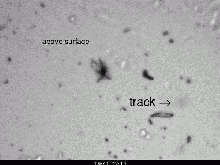“Stardust@home”的版本间差异
跳转到导航
跳转到搜索
(更正错误) |
|||
| (未显示3个用户的9个中间版本) | |||
| 第1行: | 第1行: | ||
| − | {{ | + | {{Project |
| − | | name =Stardust@home | + | |name=Stardust@home |
| − | | logo = | + | |logo=Logo_Stardust%40Home.png |
| − | | screenshot = | + | |screenshot=Focus_movie.gif |
| − | | caption =虚拟显微镜的动态对焦效果 | + | |caption=虚拟显微镜的动态对焦效果 |
| − | | developer =NASA / 加利福尼亚大学伯克利分校 | + | |developer=NASA / 加利福尼亚大学伯克利分校 |
| − | | released =2006年8月1日启动 | + | |released=2006年8月1日启动 |
| − | | | + | |app=支持图像显示以及JavaScript的浏览器 / 显示分辨率至少为 800x600 |
| − | | platform =独立 | + | |platform={{platform/独立}} |
| − | | | + | |subproject= |
| − | + | |status=运行中 | |
| − | | status =运行中 | + | |genre={{genre/人工协作}}、{{genre/天文学}} |
| − | | genre =天文学 | + | |website=http://stardustathome.ssl.berkeley.edu/ |
| − | |||
| − | | website =http://stardustathome.ssl.berkeley.edu/ | ||
}} | }} | ||
| − | |||
| − | + | [[Stardust@home]] 是一个公众科研项目,它希望志愿者来帮助搜索星际尘埃撞击所产生的痕迹,该项目于 2006 年 1 月开始正式运行。 | |
| − | + | 从 2000 年的 2 月到 5 月,以及 2002 年的 8 月到 12 月,星尘号飞船将它的“星际尘埃收集器”(SIDC),也就是总面积约为 0.1 平方米的一些气凝胶块,暴露在星际尘埃中。该收集器包含了大约 130 块 1 到 3 厘米厚的、固定在铝制腔体内硅基气凝胶。 | |
| − | + | 为了寻找星际尘埃的撞击位置,气凝胶上总共有超过 70 万个的位置都得在高倍放大后拍摄成照片,而这其中每一个位置都要拍摄 40 张,然后就组成了我们所说的“焦片”(focus movie)。[[Stardust@home]] 将把这些影片分发给网络上的志愿者。和一般的分布式计算项目不同,它不需要占用计算机的计算能力,而只是通过计算机来给志愿者分发任务。这种方法和以前的用于寻找火星上的火山的 Clickworkers 项目相似。 | |
| − | + | 志愿者必须通过一个测试后才能正式参与本项目。一旦完成注册并通过测试,志愿者就可以说访问基于网页的“虚拟显微镜”,然后就可以通过上下调整焦平面来开始搜索星尘撞击的痕迹了。 | |
| + | 作为对志愿者的鼓励,[[Stardust@home]] 将允许第一个找到特殊星尘颗粒的人来给该颗粒取名,另外,发现这些特殊颗粒的人将在相关的科学出版物上被列为合作作者。 | ||
| − | ==延伸阅读== | + | =='''项目计划表'''== |
| + | {| | ||
| + | |1999年2月7日 | ||
| + | |星尘号成功发射 | ||
| + | |- | ||
| + | |2000年2~5月 | ||
| + | |收集首批星际尘埃 | ||
| + | |- | ||
| + | |2002年8~12月 | ||
| + | |收集第二批星际尘埃 | ||
| + | |- | ||
| + | |2004年1月2日 | ||
| + | |星尘号成功穿越“Wild-2(怀尔特-2)”彗星 | ||
| + | |- | ||
| + | |2006年1月15日 | ||
| + | |回收星尘号 | ||
| + | |- | ||
| + | |2006年4月21日 | ||
| + | |开始扫描星尘号的星际尘埃收集器 | ||
| + | |- | ||
| + | |2006年5月17日 | ||
| + | |正式推出 Stardust@home 网站 | ||
| + | |- | ||
| + | |2006年8月1日 | ||
| + | |正式发布 Stardust@home 的完整版本 | ||
| + | |} | ||
| + | |||
| + | =='''延伸阅读'''== | ||
| + | *[[Stardust%40home:技术问答]] | ||
| + | *[[Stardust%40home:名词解释]] | ||
*[[Stardust%40home:常见问题解答]] | *[[Stardust%40home:常见问题解答]] | ||
| − | |||
| − | |||
2022年5月7日 (六) 14:43的最新版本
Stardust@home 是一个公众科研项目,它希望志愿者来帮助搜索星际尘埃撞击所产生的痕迹,该项目于 2006 年 1 月开始正式运行。
从 2000 年的 2 月到 5 月,以及 2002 年的 8 月到 12 月,星尘号飞船将它的“星际尘埃收集器”(SIDC),也就是总面积约为 0.1 平方米的一些气凝胶块,暴露在星际尘埃中。该收集器包含了大约 130 块 1 到 3 厘米厚的、固定在铝制腔体内硅基气凝胶。
为了寻找星际尘埃的撞击位置,气凝胶上总共有超过 70 万个的位置都得在高倍放大后拍摄成照片,而这其中每一个位置都要拍摄 40 张,然后就组成了我们所说的“焦片”(focus movie)。Stardust@home 将把这些影片分发给网络上的志愿者。和一般的分布式计算项目不同,它不需要占用计算机的计算能力,而只是通过计算机来给志愿者分发任务。这种方法和以前的用于寻找火星上的火山的 Clickworkers 项目相似。
志愿者必须通过一个测试后才能正式参与本项目。一旦完成注册并通过测试,志愿者就可以说访问基于网页的“虚拟显微镜”,然后就可以通过上下调整焦平面来开始搜索星尘撞击的痕迹了。
作为对志愿者的鼓励,Stardust@home 将允许第一个找到特殊星尘颗粒的人来给该颗粒取名,另外,发现这些特殊颗粒的人将在相关的科学出版物上被列为合作作者。
项目计划表
| 1999年2月7日 | 星尘号成功发射 |
| 2000年2~5月 | 收集首批星际尘埃 |
| 2002年8~12月 | 收集第二批星际尘埃 |
| 2004年1月2日 | 星尘号成功穿越“Wild-2(怀尔特-2)”彗星 |
| 2006年1月15日 | 回收星尘号 |
| 2006年4月21日 | 开始扫描星尘号的星际尘埃收集器 |
| 2006年5月17日 | 正式推出 Stardust@home 网站 |
| 2006年8月1日 | 正式发布 Stardust@home 的完整版本 |

